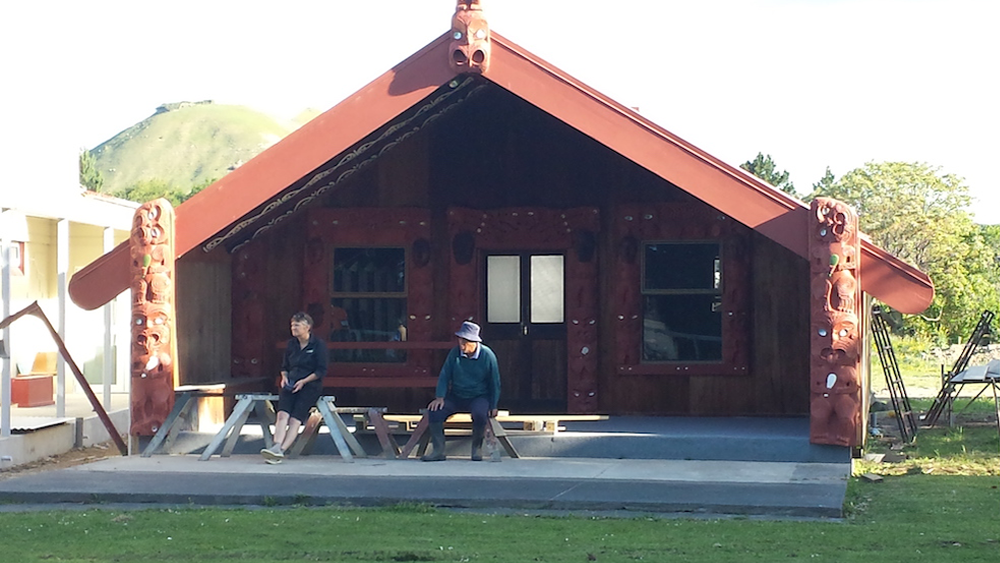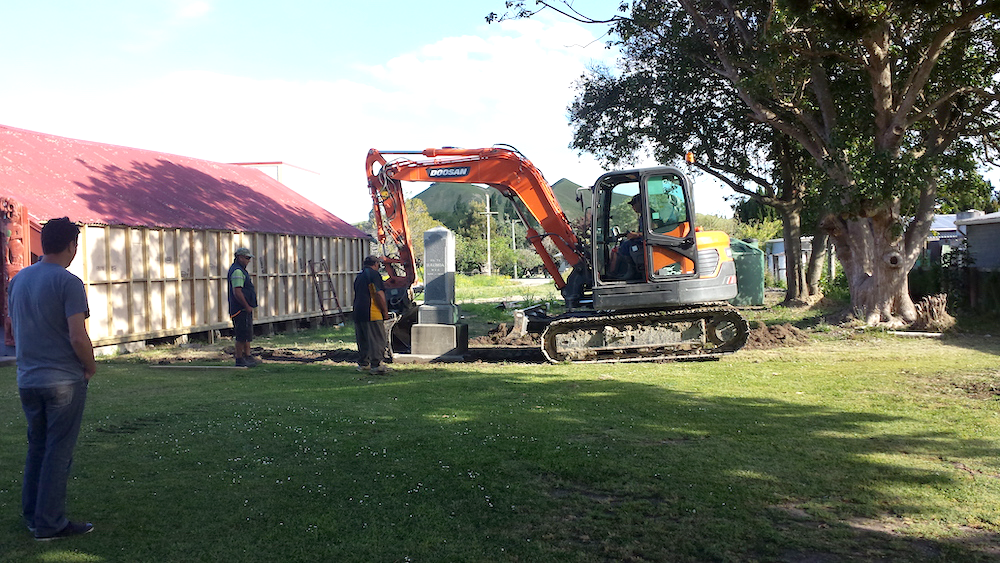A look back to conservation in the field with Heritage New Zealand – Part Two
Preserving Maori built heritage in New Zealand
This short account, is comprised of journal entries I logged throughout time spent, working in the field with Heritage New Zealand. It was a journey of connection and of self-discovery and is a tribute to the memory of my grandparents. This was an experience that left me overwhelmed emotionally, as I reconnected with my grandmother's whanau | family, and walked over the lands of my tipuna | ancestors. It has left a lasting impact on my practice and in the mahi | work, I continue with today. To the many whanau who welcomed me as part of this project, thank you for sharing your wisdom and matauranga | knowledge – for this experience, I will forever be grateful.
Te Poho o Tamanuhiri meeting house – Muriwai, New Zealand Conservation project, stage 3 – conservation of woven tukutuku panels November 10 – 14, 2014
Image 1 – Te Poho o Tamanuhiri. © Tiaki Objects Conservation.
Day 1
We left Wellington around 9am this morning, heading north west via Otaki, where we made a brief stop to make an assessment of some taonga. For the next six and a half hours, our journey veered north east, towards the settlement of Muriwai, 25km or so, south of the township of Gisborne. The day was perfect for travelling, with clear blues skies all of the way. We arrived in the early afternoon, to a hive of activity – renovations to the wharenui | meeting house, and marae complex had been well underway for a while. We pulled in just as the monument and flag pole were being relocated across the marae atea | courtyard. My nanna ma comes from here - my mother was adopted by her grandmother and raised in Manutuke a little further up the road, while the rest of her siblings were born into this settlement. The last time I visited would have been when I was a baby, however stepping out of the car was like a long awaited return home – a very strong connection was felt from the moment I arrived; a real sense of belonging.
Image 2 – Relocating a monument. ©Tiaki Objects Conservation.
Day 2
I had my first glimpse inside the whare today. The tukutuku | lattice-work panels, had already been removed from the walls inside in preparation for conservation.
Image 3 – Openings in the wall where tukutuku have been de-installed. © Tiaki Objects Conservation.
Te Poho O Tāmanuhiri is a painted whare. While it has whakairo | carvings on the exterior, it has a painted interior. This method of adornment was popular in the late 1800s to the early 1900s. Some of the best examples of painted meeting houses are in the Gisborne district.
During the initial assessment of the house, it was found to be constructed around the internal uprights, the central and back posts and the ridge beam. There was no structural bracing or insulation and the rafters appeared to be resting atop the uprights, which over time had pushed gradually outwards. The outer shell of builder’s paper and corrugated iron had literally been nailed to the internal uprights and appeared to be holding the house together. Without proper structural support and insulation, the whare had become structurally unsound risking the safety of the people and the safety of the taonga inside the whare.
Image 4 – Detail of exterior of the house. © Tiaki Objects Conservation.
Image 5 – Rear of whare. © Tiaki Objects Conservation.
Further investigations identified that sections of the painted uprights and rafters had rotted or were rotting and portions of the structural elements had bora.
Image 6 – Detail of damage to beams at the rear of the house. © Tiaki Objects Conservation.
Image 7 – Exterior surface of uprights. © Tiaki Objects Conservation.
It also appeared that spiders had been living in the house for as long as it had been standing.
Image 8 – Detail of webbing, casings and accumulated debris on the back of the tukutuku panels.
Day 3
Today, I was shown areas of the whare that had already undergone conservation treatment. This included the cleaning, infilling and in-painting of the heke | rafters, and the poupou | painted uprights. The surfaces were cleaned with the non-ionic detergent, triton 1000 in water. Areas of loss that required infill were generally structural. An infill mix of epoxy and glass micro-balloons have been used to re-integrate areas of loss. A barrier layer was applied and allowed to dry before sanding where necessary. There are varying layers of paint on the poupou, the layers from the early 20th century are likely lead based. The in-paint of these treated areas has been completed using acrylic paint artist’s emulsion.
Image 9 – Detail-interior panels. © Tiaki Objects Conservation.
Image 10 – Example of in-fill repair. © Tiaki Objects Conservation.
Conservator’s who work in the field, rely on community resources and products that are readily accessible and available. This wharenui is constructed in an open environment and is still regularly used. The decision to use commercial products is both practical and in most cases familiar to the community involved. While conducting treatments, community members are taught practical skills to support the ongoing maintenance of their whare.
Image 11 – Exterior uprights undergoing treatment. © Tiaki Objects Conservation.
Image 12 – Conservation treatment of tukutuku panels. © Tiaki Objects Conservation.
Many of the old people see Maori art, in all its forms as a continuation of Maori culture and believe the work conservators do, aids that continuation, playing an integral role in preserving aspects of traditional knowledge and culture. This transfer of knowledge is two-way; conservator’s share a practical skill-set that aids the retention of art forms such as these, also realising that work like this cannot happen without community involvement, as it is their own knowledge that feeds into the continuation and development of their art.
Part of the ongoing work during this time also included the construction of external walls and bracing, using plywood.
Image 13 – Works being undertaken on the exterior of the whare. © Tiaki Objects Conservation.
Recycled polypropylene insulation material was installed to act as a second skin for the building, providing essential structural support and improvements to the internal environment for the people and their taonga. The original outer structure was retained without too much interference.
Image 14 – Installing insulation material. © Tiaki Objects Conservation.
Day 4
We started treating the tukutuku panels today. Of the 34 or so woven panels featured throughout the house, around 17 had already been treated. Of those remaining, all were of varying size and condition. The panels were thought to have last been worked on between 1910-1912, around the time when the house would have been slowly deconstructed for movement to its current site.
Decades of dust and soot had become embedded between the slats and fibres of the front surface, while thick, dusty insect debris and webbing were visible across the back surfaces of the panels. A number of panels had been re-sized – i.e. cut, leaving a number of loose fibres visible, exposing slats along the top and bottom edges and loss of some material. Most of black fibre had become embrittled and had degraded.
Image 15 – Discolouration on the front surface of the panel resulting from dust and debris. © Tiaki Objects Conservation.
Image 16 – Detail of dust and debris. © Tiaki Objects Conservation.
My first task was to clean the front surface with triton 1000 diluted in water. The surface was agitated with a paint brush and the soiled suds removed with a powerful wet-vac. This process was repeated until the suds appeared white. Dry brush vacuuming was applied to the back surface to remove dust build up and frass.
Image 17 – A workspace was set up on the mahau of the whare. Using a brush and wet-vac to remove soiling. © Tiaki Objects Conservation.
Image 18 – Removal of soiled suds. © Tiaki Objects Conservation.
Damaged black fibres were either removed by hand or with tweezers and any loose fibres identified around the edges were also removed. Where slats had been lost, the areas were “infilled” with new slats shaped from pre-cut lengths of totara tree. Where possible these have been painted using kokowai, a traditional red-earth pigment, otherwise the colours have been colour-matched with artist’s acrylic. The loose slats have been reattached, following the same weaving technique visible throughout the panels, and using the coloured patterns as a visual aid.
Image 19 – Repairing the areas of loss in the tukutuku panels. © Tiaki Objects Conservation.
Image 20 – “In-fill” repair to the black dyed fibres on the tukutuku panel. © Tiaki Objects Conservation.
Day 5
Today, we continued our work on the repairs of the tukutuku panels. The fibre we used for the repairs is kiekie – a member of the pandanus family and a highly sought after fibre gathered from a tree epiphyte, whose leaves are harvested, processed and boiled before weaving. The white is produced by first boiling, then allowing it to dry in the sun – this bleaches the processed leaf, white. The black fibres are either dyed using commercial black dies or traditional paru - a black mud sediment, rich is iron salts. The pigments in the paru dye are acidic, so when exposed to oxygen, will begin to break down. The fibres I used were dyed with commercial black dyes, however some of the panels previously treated, were repaired using traditionally dyed leaves.
Image 21 – Repairing the fibres in the panels. © Tiaki Objects Conservation.
In repairing the black fibres, I learnt to weave this pattern called poutama. It is a cross-hatch ‘stairway’ pattern that symbolises growth, levels of attainment or advancement attained by individuals or of the iwi in general. Loose white fibres were added too, by tying new strands to the back – these were re-integrated where necessary to provide overall structural stability.
Image 22 – applying new fibres to the back of the panel. © Tiaki Objects Conservation.
Image 23 – Detail of ties in weaving fibres. © Tiaki Objects Conservation.
I feel very fortunate to have learnt to weave tukutuku from my elders and to this day, find it difficult to express how truly humbling it was. Being involved with the restoration was a privilege, and I will forever treasure the memories, the images and the experience of working on my tipuna whenua.
























